What Are the Five Main Exponent Properties? - Quiz
Choose your answer and write the correct one down. Then click HERE for the answers to this quiz.
NOTE: The transcript from the video is listed below the quiz for your reference.
1.

2.
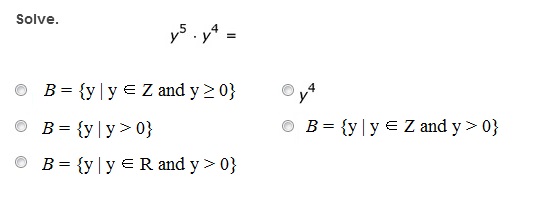
3.

4.
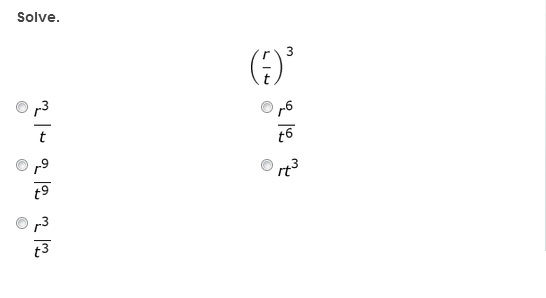
5.

We'll look at the five important exponent properties and an example of each. You can think of them as the order of operations for exponents. Learn how to handle math problems with exponents here!
Understanding the Five Exponent Properties
We are going to talk about five exponent properties. You can think about them as the order of operations for exponents. Just like the order of operations, you need to memorize these operations to be successful. The five exponent properties are:
- Product of Powers
- Power to a Power
- Quotient of Powers
- Power of a Product
- Power of a Quotient
Let's look at the first one.
Product of Powers
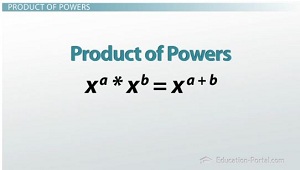 |
Here's the formula: (x^a)(x^b) = x^(a + b). When you multiply exponentials with the same base (notice that x and x are the same base), add their exponents (or powers).
Let me show you how that works. Let's say I have (x^2)(x^3). Well, x^2 is x times x, and x^3 is x times x times x. When we add all those xs up, we get x^5, which is the same thing as adding 3 + 2.
Power to a Power
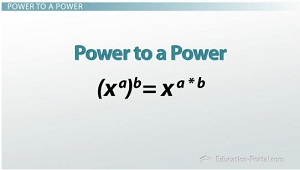 |
We can see from the formula we have (x^a)^b. When you have a power to a power, you multiply the exponents (or powers). Let me show you how this one works.
If I have (x^2)^4, which would be x^2 multiplied four times, or x^2 times x^2 times x^2 times x^2. Once again, we add all the exponents and get x^8, and x^8 is the same as x^(2 * 4), which is 8. Not too bad, right?
Quotient of Powers
 |
Remember, 'quotient' means 'division'.' The formula says (x^a) / (x^b) = x^(a - b). Basically, when you divide exponentials with the same base, you subtract the exponent (or powers).
Let me show you how this one works. Let's say I had (x^4) / (x^3). In the top (or numerator), we have x times x times x times x. In the bottom (or denominator), we have x times x times x. Hopefully, you remember that x divided by x is 1, so the xs cancel. So, x divided by x is 1, x divided by x is 1, and x divided by x is 1. So, when we cancel them, what are we left with? That's right: x^1, or just x. So (x^4) / (x^3) is just x^(4 - 3), which is x^1.
Power of a Product
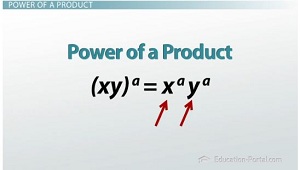 |
The formula says (xy)^a = (x^a) and (y^a). When you have a product of a power, you give each base its own exponent. Think about it as distribution putting the exponent with each base.
Let me show you how this one works. Let's say we had (xy)^2. That means we take xy and multiply it twice that means xy times xy. Well, that would give us two xs, or x^2, and two ys, or y^2. That is the same as if I distributed 2 to the x, getting x^2, and 2 to the y, getting y^2.
Power of a Quotient
When we look at this formula, we have x/y, or a fraction raised to the a power, this gives us (x^a) / (y^a). When you have a quotient to a power, you give each base its own exponent. We think of it as the exponent being distributed to each part of the fraction, just like the last one, power of a product.
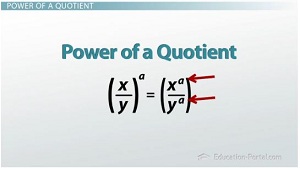 |
Let me show you how this one works. Let's say I have (x / y)^3. Remember, that means I'm going to take x / y and multiply it three times. That would be x / y times x / y times x / y. If we look at the top (or the numerator), we have x times x times x, or x^3. If we look at the bottom (or denominator), we have y times y times y, or y^3. That would give us (x^3) / (y^3), which is basically distributing 3 to the x and y .
Lesson Summary
Let's take a final minute to review the five properties.
- Product of a Power: When you multiply exponentials with the same base, you add their exponents (or powers).
- Power to a Power: When you have a power to a power, you multiply the exponents (or powers).
- Quotient of Powers: When you divide exponentials with the same base, you subtract the exponents (or powers).
- Power of a Product: When you have a product of a power, you give each base its own exponent (or distribute the exponent to each base).
- Power of a Quotient: When you have a quotient to a power, you give each base its own exponent.